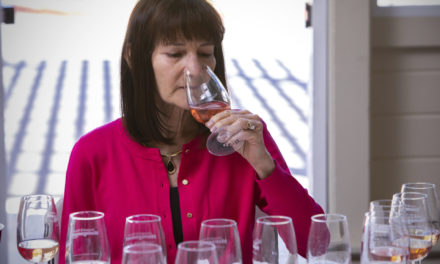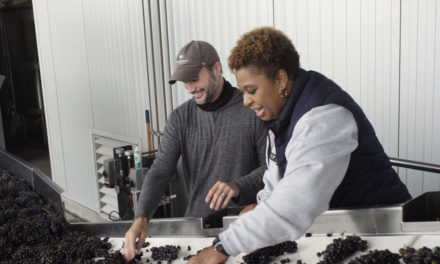California’s Santa Cruz Mountains, a sprawling AVA, was the first to be defined by elevation. The mountain range rises up from the flatness of the Santa Clara Valley, stretching from Saratoga to Gilroy. Vineyards must have 400 feet of elevation on the Santa Cruz or western side, whereas they must be at least 800 feet on the eastern side. Here, on the AVA’s southeastern border, one of the region’s most sought after vineyards is perched at the foot of Mount Madonna.
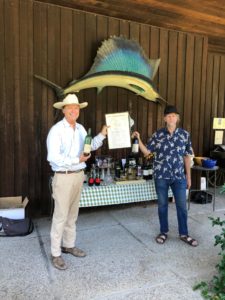
Charlie Bates and Jeff Emery of Santa Cruz Mountain Vineyard
Amble down historic Redwood Retreat Road (where, in the 19th and early 20th centuries, many a fog-chilled San Francisco socialite came in horse and carriage to relax in the warm comfort of the redwood forest), and you’ll find a nearly 1,000-acre paradise of sprawling hills, horse trails, and heritage oaks. You’ll also encounter a vineyard that grows some of the most stellar cabernet sauvignon and cabernet franc in the entire AVA. This is Bates Ranch, home of cowboy, horse lover, rancher, grape farmer, and serious history aficionado Charlie Bates.
History in Every Room
Everywhere you look you’ll spy tributes to the roots of this place, including striking photos of Bates’ father, Jack, original western art gracing the wooden walls, bullfight posters, candelabras, tile murals, branding irons, etched old wine bottles, and framed accolades from publications that no longer exist. The farmhouse, designed by William Wurster, former dean of the UC Berkeley School of Architecture and the School of Environmental Design, is a brilliant backdrop for the artwork, bronzes, and photo albums documenting the history of the Ranch.
One album depicts a young Robert Kennedy, then U.S. Attorney General, standing in front of the white station wagon he’d hauled his kids in cross country to meet with Jack. Sans Secret Service agents, Kennedy drove up the dirt road to the farmhouse, bent on offering Jack a job in Washington, D.C. Jack Bates, a renowned trial attorney with San Francisco-based Pillsbury Madison & Sutro law firm—and a Republican—politely declined.
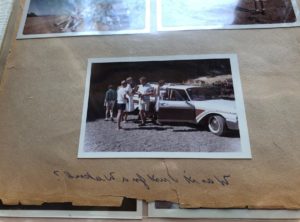
A Kennedy connection
Charlie remembers having a bit of a tussle with the eldest of the Kennedy boys, who offered him a hamburger and then rudely stuck his thumb in it. A fisticuffs ensued. No hard feelings, though. Charlie tells this story with great pride, adding that it was during this time that Marilyn Monroe died, and some wanted to finger Bobby, who was rumored to have provided his AG office in Washington, D.C.— the only one with a bedroom at the time—to his brother, Jack, for his dalliances with the bombshell blonde. The photos in the album prove Bobby’s indisputable whereabouts.
From Ranch Retreat To Vineyard
Bates Ranch came to be the Bates family home when Jack and his wife, Nancy Witter (whose father helped establish the brokerage firm Dean Witter & Co.), fell in love with the place and bought the 700-acre parcel for $125,000 in 1958. The two enjoyed riding horseback, running cattle, and teaching their kids to love the outdoor life.
Although there are still cattle here, these days the main business of Bates Ranch is grapes. The vineyard itself is called Janaca, a composite of the initials of Charlie’s father Jack, mother Nancy, Charlie himself, his sister Cathy, and his brother John.
Planted in 1970, the Janaca vineyard provides 22 acres of cabernet sauvignon, cabernet franc and grenache to some very familiar names in the region: Jerold O’Brien of Silver Mountain Vineyards, Andrew Brenkwitz of Byington Vineyard & Winery, Kenny Likitprakong of Ghostwriter, Matt Oetinger of Fernwood Cellars (who planted the grenache here), Ian Brand of I Brand Wines, and John Ritchie of Bottle Jack. Rob Bergstrom of San Francisco’s Sandar & Hem makes quite a lovely rosé from the top part of Bates.
The label for the family’s wine brand, Bates Ranch, bears a stylized image of Jack Bates on horseback, overlooking his vineyard. It was created by famous Marin County artist Stan Galli, who became a family friend. Charlie says the original rendition showed Jack’s nose sticking out from under the brim of his cowboy hat. “Dad asked Stan to bring it back under the brim,” says Charlie. While his dad was used to sticking his neck out, he was a bit more careful about his nose.
The Perils of Growing Grapes
The first two years of grape wrangling proved rough for Charlie and Jack. In 1971, they lost the entire crop to frost; the following year, 70 percent of it was lost to rain. Luckily, they stuck with it and fortunes turned around. “In 1976, Val and Dexter Ahlgren of Ahlgren Vineyards [in Boulder Creek, Calif.] were the first of the Santa Cruz Mountains wineries to buy fruit from us.” The word quickly spread and soon, Bargetto Winery (in Soquel, Calif.) was buying fruit also.
Ken Burnap, who founded Santa Cruz Mountain Vineyard, made wine from Bates Ranch continuously from 1978 through 1994, relying on a hired hand from UC Santa Cruz, by the name of Jeff Emery, to process the fruit. Emery says one year, they hand-pressed more than 42 tons of cabernet sauvignon onsite—an enormous undertaking. Emery took over the Santa Cruz Mountain Vineyard label when Burnap retired and considers Bates Ranch some of the finest cabernet in the region.
Proof in The Glass: Tasting History With Jeff Emery
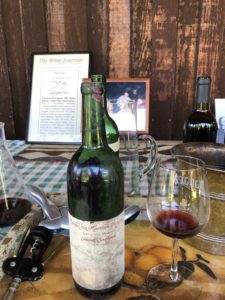 At the end of July, I visited Bates Ranch with renowned viticulture consultant, Prudy Foxx, along with many of the winemakers mentioned above. We tasted Emery’s 1978, 1982, 1985, and 1989 Bates Ranch cabernet sauvignons. To a person, we were astounded by their vibrant complexity, resolute but silky tannins, and the sense of foreverness they possess.
At the end of July, I visited Bates Ranch with renowned viticulture consultant, Prudy Foxx, along with many of the winemakers mentioned above. We tasted Emery’s 1978, 1982, 1985, and 1989 Bates Ranch cabernet sauvignons. To a person, we were astounded by their vibrant complexity, resolute but silky tannins, and the sense of foreverness they possess.
A few bottles from 1978 still remain, and the wine is fully alive, with its fruit and tannins intact, as well as a wonderful acidity that keeps it fresh. Mind-blowing stuff, really, unlike anything else from California I’ve tried from that vintage. At first, it exudes that wonderful cellar funk, then reveals Crayola crayons, cedar chest, roasted shitake mushrooms, feta cheese, and kalamata olives. The serial savory elements of this wine were a revelation. Going back to it over and over showed off something different in every whiff and sip, the hallmark of a wine on an upward arc. It’s not about to go gently into that good night.
On to 1982, a drowned rat of a vintage that Emery will never forget: Mudslides closed every road in the Santa Cruz Mountains region, killing 22, including 10 at Love Creek. This was followed by a drought, which ushered in a very hot 1985, the year the huge Lexington blaze jumped highway 17 near Scotts Valley, threatening thousands of homes and lives. Emery calls them “perfect bookend vintages.” I call them “Years of Flood and Fire.” That wines from these harvests exist is testament to the human spirit.
The 1982 Santa Cruz Mountains cab is simply astonishing, exhibiting the extra mile of hardship the grapes endured that year. It comes on like a crescendo of youthful cherry fruit, with silky oh-so-refined tannins and a phenomenal forever finish. Really incredible now, this baby will hang on for another 25 years, no problem. The 1985 reveals a larger, fleshier wine overall, with bigger, more gravelly tannins and a very appealing mouthfeel. It’s got another 20 years on the speedometer.
Emery also shared his 1989 “earthquake” vintage from Bates. Winery owner Ken Burnap was in Mexico when the quake struck, leaving Emery to deal with a cellar that was turned end on end. That any of this wine survived is a bloody miracle. To taste it now renders you speechless. Its overall brightness, depth, structure and length compose a wine that is, in a word, awesome, and an enduring testament to the relentless horsepower of this vineyard. This one can go the distance for another 30 years as well. Emery knows how to build them right.
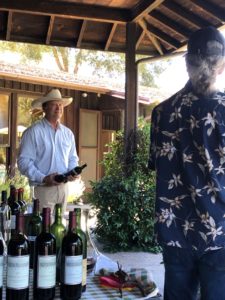 Also of note among the older wines presented were the 2010 and 2011 Silver Mountain Cabernets. The 2010 is very cherry-focused, bright with fruit and divinely alive, while the 2011 is filled with cedar, olive and juniper, along with a fantastic blueberry core. Both have the stuffing to go another 20 to 30 years.
Also of note among the older wines presented were the 2010 and 2011 Silver Mountain Cabernets. The 2010 is very cherry-focused, bright with fruit and divinely alive, while the 2011 is filled with cedar, olive and juniper, along with a fantastic blueberry core. Both have the stuffing to go another 20 to 30 years.
A Bright Future: The Next Gen Carries On
On the youthful end of the spectrum, we sampled Bottle Jack Winery’s 2018 Bates cabernet sauvignon and a barrel sample of the 2019. Winemaker John Ritchey found Bates Ranch through working with Andrew Brenkwitz at Byington Vineyard & Winery (Los Gatos, Calif.), who makes the wines for Charlie Bates under the Janaca label.
“Andrew used to break out the Bates cab after a long day during harvest, and we would just marvel. In 2017, I lost the cab fruit I thought I was getting and Prudy Foxx came through with two tons of Bates. It was at the upper end of ripeness for us, and netted around 14.6% alcohol,” remembers Ritchey. This is big stuff, firm and focused, with black pepper, brambles, a pop of dark cherry, along with cigar and huge leather, which are classic California cabernet descriptors.
Ritchey dialed things back in 2019. His barrel sample (no oak) showed pure fruit, highlighting black cherry, grippy tannins, and generous depth. It will be aged in both French and American oak barrels before bottling.
Let’s not overlook the Bates cabernet franc, which is, to me, the quintessential representation of this grape from this AVA, at least when picked modestly ripe and not over the top, say 21.8 to 22.9 Brix.
Ian Brand’s 2015 Bates cab franc (13.5%) exhibits those gorgeous lavender, rose petal, and pine forest aromatics that makes Francophiles swoon. The silky tannins are utterly divine. The 2017 (12%) is pushing it into French Bordeaux territory, giving off scents of green pine and rose petals, asserting bright snappy red raspberry and capers on the palate. Ian’s fascinating 2018 cab franc (12.88%) shows extraordinary perfume, raspberry, lavender, and bit of geranium and Hatch chile.
Brand had been trying to get Bates’ cab franc since 2009, when he tried Emery’s 1979 Bates cabernet sauvignon. “This was during the ‘Parkerization’ of wine,” admits Brand. “I told him to pick later and use more oak! Fortunately, he educated me on the value of picking for the continuity and length of the wine.”
Emery has no use for trends—and that’s a good thing. While definitely a traditionalist, he might be easing up a bit on the austerity. The 2018 Bates cabernet barrel sample shows big gobs of grippy fruit and a lovely pirouette of acid, showing off a texture already so sublime it’s hard to believe it’s so young. Emery’s 2017 cabernet sauvignon is so wildly redolent of Peace rose perfume, I thought it was cab franc. Blessed with statuesque structure, it flaunts pure unabashed raspberry on the palate, flowing with impossibly enormous, yet somehow fine-grained tannins, and finishing with chocolate mint.
Coveted Fruit
It’s no wonder so many winemakers want to make wine from this vineyard. Some, including Kenny Likitprakong of Ghostwriter, have spread the word about this vineyard far outside the circle of its home AVA. If you visit Ashes & Diamonds in Napa Valley, for example, you’re likely to hear the staff bragging about their favorite wine, which just happens to be a cabernet franc from Bates Ranch. The waiting list is long to get this fruit, but sometimes connections help get you an in.
Livermore winemaker Steven Mirassou, who, along with his son, Aidan, and assistant winemaker, Beth Refsnider, craft the outstanding wines for the Steven Kent Winery and Lineage portfolios, were thrilled to get both cabernet sauvignon and cabernet franc from Bates Ranch this year. At the late July tasting, Steven told me he’d never imagined that a California vineyard could have such a kinship with Bordeaux in its ability to produce wines that capture the uniqueness of place, year after year. His 2020 Bates wines are now in barrel in Livermore, and Mirassou describes them as “awesome.”
The consistency and the longevity, the promise of the Bates Vineyard wines to last decades, while continuing to deliver enormity of structure, interest and pleasure, is something very few existing California cabernet sauvignon sites can demonstrate.
After bidding Charlie goodbye on that hot July day, I drove down the long dusty road, past the huge California flag draped in the old oaks, and a saddle perched atop a set of barrels. For just a moment, I imagined I heard a stagecoach driving down Redwood Retreat Road, taking passengers to their destination somewhere in this last bastion of the West.
Here, in this living time capsule, the past is ever-present, and you can literally taste history in every glass.


